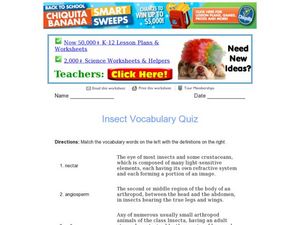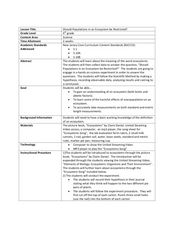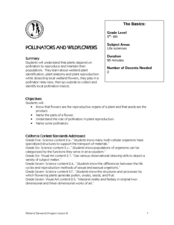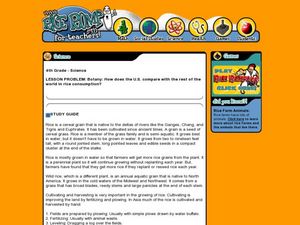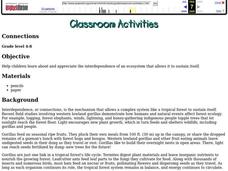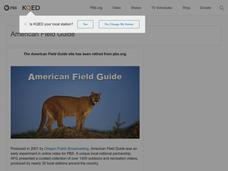Curated OER
The Giving Tree Gives
Students study both poetry and science in this language arts activity for early elementary, Special Education, and LEP students. They listen to Shel Silverstein's, The Giving Tree, and discuss its contents. They graph apple types, make...
Curated OER
Let's Sort a Salad
Students examine edible plants by identifying salad ingredients. For this botany lesson, students discuss the different vegetables that can be eaten in a salad and draw them on a worksheet. Students review vegetable vocabulary and...
Curated OER
Arbor Day Vocabulary Quiz
In this Arbor Day vocabulary worksheet, students draw lines to match ten words pertaining to trees to their definitions. Some prior knowledge or research is assumed.
Curated OER
Pollination
Third graders discuss pollination and how bees pollinate flowers. In this pollination lesson plan, 3rd graders draw the pollination process on a piece of paper.
Curated OER
Teeth and Eating
Learners conduct online research of different animals and their diet. In this animal lesson, students identify the various types of diets each animals has and their teeth. This research is done on the Internet.
Curated OER
Insect Vocabulary Quiz
In this insect vocabulary worksheet, students draw lines to match ten words pertaining to insect anatomy to their definitions.
Curated OER
Plants Group Creative Writing
In this plants writing worksheet, students collaborate with classmates to write a group story about plants. Students have 25 minutes to write the group story using all 10 of the words in the box.
Curated OER
Now You Have It, Now You Don't
Learners compare shipping peanuts made from corn and made from Styrofoam. In this corn based peanuts lesson, students understand why to use eco-friendly materials for packing. Learners participate in an experiment to compare the...
Curated OER
Do Plants Need Water?
First graders observe the effects of varying amounts of water, sun, and air on lima bean plants. They also predict and describe their outcomes in a written report.
Curated OER
Genetics Practice Problems-Simple Worksheet
In this genetics practice worksheet, students answer fifteen questions about homozygous and heterozygous genotypes and simple monohybrid crosses of traits. They determine genotype and phenotype ratios by completing Punnett squares for...
Curated OER
Should Populations in an Ecosystem be Restricted?
Fourth graders experiment to determine how overpopulation effects ecosystems specifically plants. In this ecosystem lesson, 4th graders conduct an ecosystems experiment after listening to Claire Daniel's, Ecosystems. They watch a video,...
Curated OER
Pollinators and Wildflowers
Students explore how plants depend on pollinators to reproduce. In this pollination lesson students dissect a local flower and collect and identify pollinating insects.
Curated OER
Where Do Plants Get Their Food?
Students think about the historical development of the scientific method. They design an experiment that replicates van Helmont's, using only specified materials. Pupils then improved upon van Helmont's procedure and also consider the...
Curated OER
Pea Plants Dihybrid Cross
In this dihybrid cross worksheet, students are given four crosses to complete using punnett squares. They determine the genotypic and phenotypic ratios of the offspring.
Curated OER
Mendel Pea Plants
In this Mendelian genetics worksheet, students answer a variety of questions about Mendel's experiments and discoveries and they practice determining probability of outcomes in pea plants.
Curated OER
Quality of Rice
Sixth graders research how farmers irrigate, harvest, and keep high standards of rice. In this farming lesson, 6th graders discover how rice, wheat and soy beans are farmed. Students make a chart showing the similiarities and differences.
Curated OER
Animals, Soil, Trees
Fourth graders describe the various kinds of soils and how plants and animals are affected by them. They describe the baic needs of plants, scoring at least a 3 or 4 on a 4-point rubic. Students are able to predict and/or infer what...
Curated OER
And Just How DO You Kill A Weed?
Students explain chemical, cultural and biological weed control methods. They design and conduct an experiment to simulate a weed control method and explore various ways to prevent weed dispersal.
Curated OER
Prairie Restoration and Prairie Ecology
Young scholars collect data as they identify and classify native prairie plants and insects. They create their own population study using a variety of sampling techniques to determine the population density of various species. Students...
Curated OER
Rice Consumption
Fourth graders discover facts about rice and how it is farmed. In this rice research lesson, 4th graders investigate how much rice is eaten in the United States compared to other countries. Students research countries and graph the...
Curated OER
CONNECTIONS
Students study the interdependence of an ecosystem that allows it to sustain itself. They examine the Western lowland gorillas for an example.
Curated OER
Sequence Writing: Life Cycles - Plant Life
Students investigate the stages of plant life. Students create a K-W-L chart. They describe six main stages of the plant life cycles. Using stickers, students create a life cycle flow map.
Curated OER
Bean Sprout
Student will track the growth of his/her bean sprout with sunlight and without sunlight over the course of 3 weeks. They will enter the results into an excel data base then graph the results of both variables to make the comparison.
Curated OER
Flowers and Plants
Students are assigned to bring five flowers. They explore flowers to distinguish different physical features of flowers. They compare and contrast different flowers to determine what features they have in common. Students develop an...







